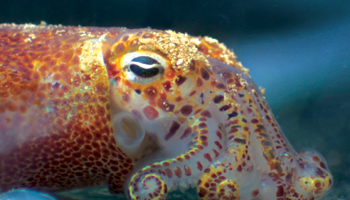From sea to squid, thanks to slime
Goo-making genes help luminescent bacteria colonize symbiotic partner
- More than 2 years ago
BOSTON — Making mucus is nothing to sneeze at for a tiny Hawaiian squid.

Young bobtail squids secrete the goo to attract light-emitting bacteria, which swim inside the squid and take up residence, helping it hide from predators. Now researchers have learned that the bacteria make their own mucus, a slimy matrix of polysaccharides. Clues about which bacterial genes are involved in the goo-making suggest that the slime is critical for successful squid colonization, scientists reported June 3 at a meeting of the American Society for Microbiology.
“This finding that polysaccharides are critical for colonizing is totally new,” comments Margaret McFall-Ngai of the University of Wisconsin-Madison.
Baby bobtail squids are born without their bacterial partners and must recruit them from the surrounding seawater. Once inside the squid, the light-emitting bacteria Vibrio fischeri set up shop in narrow cavities known as crypts. The tiny squid, Euprymna scolopes, weigh about 2.5 grams as adults. By day, the squids nestle in the sand; at night they hunt for food around shallow water reefs. When a squid is foraging in the moonlight, its dark silhouette would be visible to predators and prey from below, but the creature is camouflaged by its light-emitting partners. The amount of light emitted by the squid-dwelling Vibrio usually matches the intensity of the moonlight.
Scientists think that this counter-illumination, cast towards the sea floor, helps hide the squid from hungry fish.
The Vibrio bacteria also can live freely in the open water, and little is known about their path from sea to squid. To investigate, Karen Visick of LoyolaUniversity in Chicago looked into which bacterial genes are important for colonizing squid.
Visick and her team looked for Vibrio mutants that had difficulties settling down in the crypts. Normally there are about 100,000 bacteria per squid, but the researchers found that when the bacteria lacked a working copy of a particular gene, about 40 percent of them didn’t colonize the squid. The gene was very similar to bacterial genes known as sensor kinases, which code for certain proteins that take in information from the environment and then pass the information to other proteins inside the cell.
The researchers also looked for the gene in charge of making the proteins that receive the information relayed by the sensor kinase proteins. In the lab, V. fischeri normally make smooth, shiny colonies. But when the researchers disrupted a gene known as syp, the bacteria couldn’t make their smooth polysaccharide goo, Visick reported in Boston. Vibrio’s sensor kinase gene and syp gene appear to make proteins that work together to make the polysaccharide slime of the right consistency. This slime might help the bacterial cells stick together and also might help them stick to the squid-secreted mucus, Visick says.
“What I find exciting is that we still know so little,” says Visick. For example, the squid expel about 90 percent of their bacteria at dawn before burrowing into the sand. The remaining bacteria multiply during the day and, come evening, the squid go hunting again with their luminescent partners. Why do the squid undergo this morning expunging? Scientists are still in the dark.






